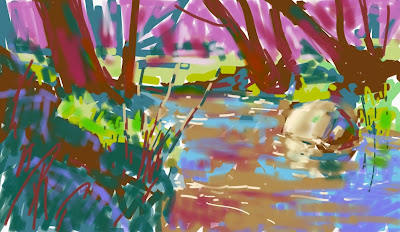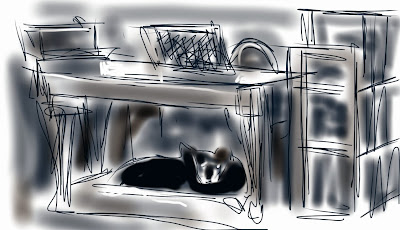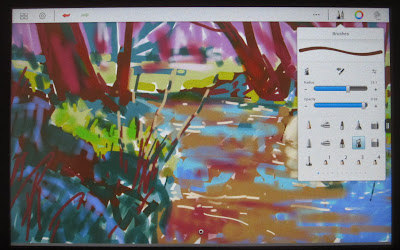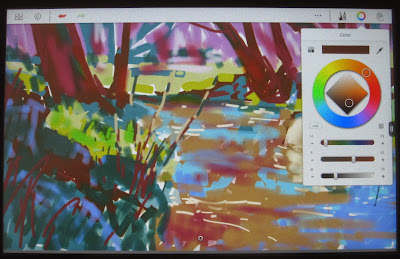 |
| Vermillion Cliffs cast a shadow on Echo Cliffs at sunset |
No, we're not talking about comic strips here. The "Arizona Strip" is that part of Arizona that lies north of the Colorado River and the Utah border. It's sort of a no-man's land, a stark but beautiful landscape. I had the opportunity this past week to spend several days painting the Arizona Strip with my friend
M.L. Coleman. We traveled about 500 miles in his 22-foot Lazy Daze RV to visit such places as the
North Rim of Grand Canyon National Park,
Vermillion Cliffs National Monument,
Marble Canyon and
Lees Ferry.
 |
| Near Lees Ferry |
A break in an oil coolant line in the RV and problems with getting replacement parts delayed our departure until Tuesday. That was just as well, since a small weather front moved through on Monday, dropping snow in the high country. Tuesday morning dawned cool and clear in Sedona, so we headed up toward Page. Getting to Page, however, was out of the question because of the
monumental "slump" in the road bed of Route 89. This happened over a year ago, and it still has engineers scratching their heads over how to fix it. This was not a problem for us, though, since we weren't trying to get to Page. To reach the Strip, you head west on 89A a few miles before Page. I bring up the "slump" to show you how the strange geology in northern Arizona can puzzle even the experts. This geology is what painters go to the Strip to paint.
After a four-hour drive, we ended up near Lees Ferry, which marks the one place in Arizona where you can easily cross the Colorado river via boat. Lees Ferry, as a historic site, is administered by the National Park Service. Here's what the NPS web site has to say:
Lees Ferry is the only place within Glen Canyon where visitors can drive to the Colorado River in over 700 miles of Canyon Country, right up to the first "rapid" in the Grand Canyon. A natural corridor between Utah and Arizona, Lees Ferry figured prominently in the exploration and settlement of Northern Arizona. Lees Ferry is now a meeting of the old and the new.
Lees Ferry sits hunkered down beneath the Vermillion Cliffs. The Cliffs are about 1500+ feet high and yes, the name is accurate. Even at high noon, when color is usually washed-out, they glow a stunning vermillion hue. In the evening, as the sun drops in the west and the shadows grow, they become breathtaking. We arrived at the campground in time to do a quick painting before sunset.
 |
| Camping at Lees Ferry |
Surprisingly, the campground was mostly empty. I imagine it must get busy sometime, since it had not one but two campground hosts. Save for a couple of generators running - they both stopped by 8:30 - it proved a quiet place to spend the night. It was the only night we spent in a campground; other nights, we "boondocked," as RVers call it, finding a quiet spot off the road. The Strip is mostly either National Forest or BLM (Bureau of Land Management) land, and you can camp anywhere but in the Vermillion Cliffs Wilderness, which is off-limits to internal combustion engines. If you want a superbly quiet night with plenty of stars but without smokey campfires and noisy generators, this is how to get a great camping experience.
After painting, we had dinner. All our meals were simple. M.L.'s wife had roasted a chicken and made some soup that we brought with us; otherwise, M.L. cooked steak (beef and pork) and always made a small salad. For lunches, I'd brought some bagels and peanut butter; M.L. shared his carrot and celery sticks with me, and always gave me a thumb-sized chunk of Dove chocolate for dessert. Breakfasts were a scramble of eggs, veggies and some sort of meat. As a swap for his cooking, I was in charge of washing dishes. Doing any kind of food prep, dish washing - and also personal bathing - in an RV requires careful monitoring of quantities. We had about 40 gallons of fresh water in the tank, and I had no idea how capacious the grey water tank was. But a gauge showing levels of fresh water, grey water, sewage, propane and battery power was very useful in helping us trim our usage of resources. (I should mention that we returned home with about a third of our fresh water and our propane unused. M.L. says he can usually go about five days in the RV without dumping grey water or sewage.)
 |
| Pulled over for a quick one (no, it's not a scene from 'Breaking Bad') |
That night, the temperature plummeted. It was our coldest night. When I woke just before dawn to get the coffee perking, it was 31 degrees inside the RV and, I think, 28 degrees outside. I'd brought an old Coleman sleeping bag, which was totally inadequate, as well as a down "mummy" bag. But rather than use the mummy bag, which though warm can be rather confining, I chose the Coleman. I had a cold "skunk stripe" down my back all night where I had failed to zip up the bag. For the rest of the adventure, I used an old National Park Service sleeping bag that M.L. had brought. (He once worked for the Park Service.) I don't know what the bag is made of, but I stayed toasty warm no matter how cold it got. (We left the heat off at night, turning it on only when we got up in the morning.)
Wednesday, we headed out of the campground toward the North Rim. I'd never been to the North Rim and was excited to be heading that way. But first, we did a quick painting on the road somewhere beneath the Vermillion Cliffs. After that, our first stop was Jacob Lake to fill up on fuel.
 |
| Lodge at the North Rim |
Jacob Lake sits at just a hair below 8000 feet. It was noticeably colder, and the price of gas noticeably higher. It was another 43 miles from Jacob Lake to the North Rim, and we were averaging 10 miles per gallon. A big sign flashed, "North Rim Open - No Services." So, filling up made sense. And the sign was right - no services were open at the North Rim, but the Park itself was. But only barely. We were disappointed to learn that the roads to Point Imperial and Cape Royal were closed. The only road open was the main one to the lodge.
 |
| North Rim view, looking to South Rim |
The North Rim sits about a thousand feet higher than the South Rim, and it gets considerably more snow. Because of this, it closes on October 15th each year, but remains open for day use until snow closes Route 67 from Jacob Lake. Since the snow from Monday's storm had pretty much vanished, we imagined the park roads that led to interesting painting spots would be open. Not so. We talked to a Ranger, and even though the recent US government shutdown had re-opened the park, it was too late to re-staff the Park. So, since there was no one left to patrol the roads and help visitors who might need assistance, the roads were closed. Worse yet, the lodge itself was being re-roofed and was cordoned off by yards of yellow tape, which also prevented access to other trails along the rim.
Despite all that, we were able to do a nice hike out to Bright Angel Point and to paint a little. The North Rim affords different vistas than the South. Rather than being perched on a sheer cliff looking straight out and down, you are on cliffs and shoulders that project out into the canyon with gentler slopes below. You're also a lot closer to many of the buttes and features you see from the South Rim; M.L. told me that, at Cape Royal, you could almost reach out and touch Wotan's Throne.
 |
| My North Rim painting, in process |
 |
| Photo by M.L. Coleman |
Here's a short video panorama I shot from the rim:
The North Rim campground was, of course, closed, so we headed out to find a spot in the adjacent National Forest where we might camp. One of the Rangers helpfully told us about a Forest Road that would take us out along the Marble Canyon rim, if we wanted to go that far. Since the sun was setting fast, we didn't. Instead, we ended up about four miles up a gravel road that took us to a trailhead for the Arizona Trail, right next to the Saddle Mountain Wilderness. It was a beautiful, quiet spot, with only one other camper. (They were from Holland and had spent the last 14 months driving up from Cape Horn, but that's a different blog post.)
 |
| View from East Rim, down toward North Canyon |
It was another cold night - this time we were lodging at 9000 feet - but Thursday morning dawned clear, and the sun warmed things up nicely. We painted in the sun along what's called the East Rim, overlooking North Canyon. We had a fine view of Marble Canyon, the smokestacks of the Page power generating station and Navajo Mountain in the distance. I even hiked down the Arizona Trail a bit to stretch my legs.
I should mention the difficulty of painting with cold oil paint. My white, especially, resembled putty more than paint. The old-time outdoor painters used to add kerosene to the paint to loosen it up in the cold. I didn't have any kerosene available, so I added a little Archival Lean Medium to it, which helped. Positioning my palette so the sun hit it helped, too. If I'd been smart, I would have put my tube of white paint in the drawer over the RV's heater vent. I already had my toothpaste and sunblock in there so they would be warmed up by the heater.
Afternoon came with a few clouds, and we decided to paint a few aspens in the hazy light. It's almost as if we were painting according to a checklist of Arizona scenery . Tall cliffs and shadows, check. North Rim of the Grand Canyon, check. Aspens, check. We would move on to include arroyos (check), chamisa (check) and water (check.)
 |
| Evening light on the Vermillion Cliffs |
That evening, we drove back through Jacob Lake and then down to a lower elevation of 5000 feet or so to find a place to boondock along Route 89A. Because of the imminent sunset, we didn't have time to research a location as much as we might have liked, so we ended up about 50 feet off the highway. Fortunately, 89A traffic petered off after sunset. The following morning, I took a short walk along a fence line and discovered an official BLM parking lot and trailhead to Soap Creek just a couple of hundred yards from where we had camped. Even so, we had a beautiful sunset with the the Vermillion Cliffs to the north and the Echo Cliffs to the east all lit up with red fire. A crescent moon was also beginning to show.
Friday morning we went in search of more cliffs with shadows and arroyos with chamisa. The arroyos required a little driving back and forth to find suitable pull-offs and arroyo walls that ran north-south to give us good afternoon shadows. (In the desert southwest, shadows make all the difference between a good painting and a lousy painting with flat lighting.) I'd always wanted to paint chamisa in raking sunlight in an arroyo.
 |
| Tracks |
By the way, for most of my paintings, I stuck with a 9x12 size, mostly because of RV storage space and the lack of a suitable wet canvas carrier for anything larger. I did bring several 5x7s and used my Art Cocoons to hold those. M.L., on the other hand, went larger - 12x16 and beyond - and the RV has some built-in cabinets to hold his paintings. The last couple of days, he dragged out his Take-It-Easel and went even larger - 16x20. He paints almost exclusively with a couple of large knives, so it doesn't take him much longer to paint one of those than it does me a 9x12.
 |
| M.L. Coleman painting Lees Ferry |
Saturday, our last full day of painting, we went to Lees Ferry. From a short hill just before the boat launch, we had a fine view of the bend in the Colorado River by the boat launch. There were even some golden cottonwoods by the water (check). The cliff on the far side of the river stayed in shadow a long time, giving me time to paint two pieces. I borrowed one of M.L.'s knives to paint the first one.
 |
| My borrowed knife and Lees Ferry painting, in process |
What did we do in the evening? We had to finish painting by 4:30 in order to get a campsite by dark, and we didn't eat dinner usually until about 8. We always spent a little time outside at sunset to take photographs and to marvel at the color of a clear November evening in Arizona. After that, we'd talk about art business and maybe even gossip a little. After dinner, I went to bed with my Kindle to read, although I didn't last long before sinking into sleep. I'd brought along a couple of art-related magazines, but there wasn't much time for any of that.
 |
| Crescent moon over the desert |
After a final night of boondocking, we had breakfast and headed south. We stopped for one last painting in Cedar Ridge. This was in Navajo country, on the reservation. As we were finishing up, we had two sets of visitors. The first was an elderly Navajo couple who arrived in a recently-washed, white pickup. They were dressed in their Sunday finest, he with a brightly-polished silver belt buckle. "That is our house," the woman said, pointing into the scene that M.L. was painting. They admired our work and said mine looked just like a photograph. That is, of course, the last thing I want my paintings to look like, but I knew that it was meant as the highest form of praise, so I thanked them. The second set were from China, puzzled by the fact that they couldn't get to Page and that their smartphone wanted to them to take for a detour the dirt road leading into the Navajo settlement behind us. We weren't sure how to get to Page, either, so we sent them down to the gas station in Gap for directions.
At the very end, M.L. didn't know what to do with the 12x16 he'd just finished. He'd run out of storage room. So, into the oven it went. Helpful Hint from Heloise: In a pinch, your RV oven can make a nifty wet canvas carrier! I hope he remembered to take it out.
This kind of trip with another artist is a rare treat, filled with camaraderie and a lifting of spirit. I got several good paintings out of it, but I got a lot more than that, too.
Below are a selection of the paintings I did on the trip. These are all 9x12 (or 12x9, depending on orientation.) Some are on panel, others on linen. The ones on linen are from
Plein Air Panels; it was my first time using them, and I have to say, they are beautifully made. I don't usually like working on a cloth surface, but these are made with Claessen's #66 Belgian Linen, and they are superb. I will probably put these paintings up for sale in the near future when I have photographed them properly and finished them off. As they say, watch this space for details! (
In the meantime, please check out my continuing holiday sale for some great deals.)
 |
| East Rim Aspens, 9x12 oil/panel |
 |
| Ledge, 9x12, oil/linen |
 |
| Shoulders, 9x12, oil/linen |
 |
| From the North Rim, 12x9, oil/linen |
 |
| Vermillion Cliffs, 9x12, oil/panel |
 |
| From Lees Ferry, 9x12, oil/panel |
 |
| Towers, 9x12, oil/linen |
 |
| From the East Rim, 9x12, oil/panel |
 |
| Lees Ferry I, 9x12, oil/linen |
 |
| Lees Ferry, 9x12, oil/panel |
 |
| At Cedar Ridge, 9x12, oil/linen |
 |
| Chamisa, 9x12, oil/linen |
 |
| Everything! |




































.jpg)



























